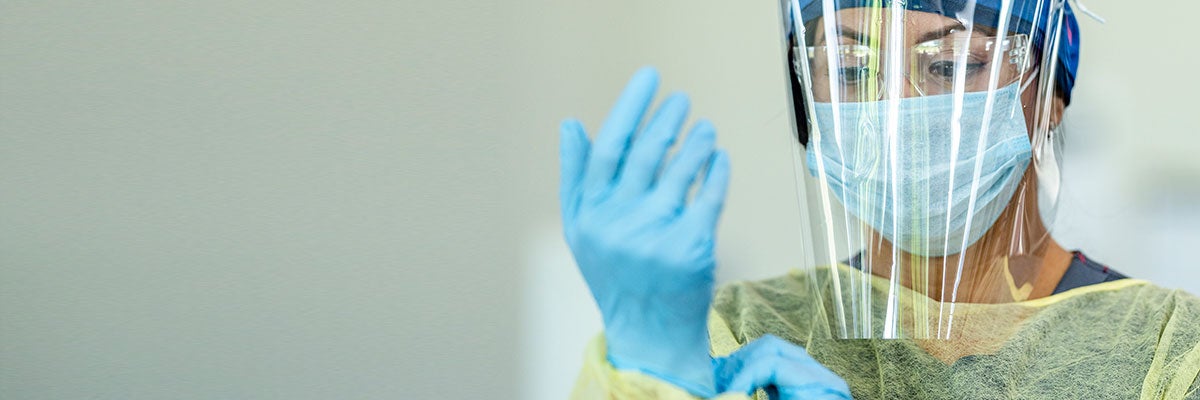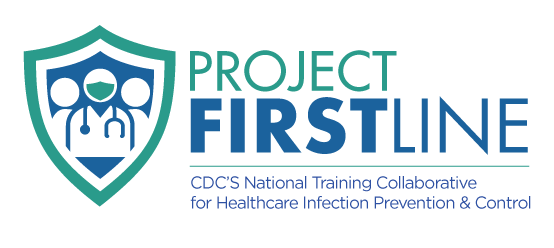
Project Firstline EVS Cleaning & Disinfecting Job Aids
EVS Cleaning & Disinfecting Matrix
As part of the Project Firstline initiative, the AHA and AHE have released two cleaning and disinfecting job aids for frontline EVS professionals and their supervisors to use in their efforts to practice proper cleaning and disinfection in a variety of health care settings.
As the front line of the health care infection prevention team, environmental services (EVS) staff, play an essential role in the fight against the spread of infection - one that creates a cleaner, healthier and safer environment for patients, visitors, and employees. The two EVS cleaning and disinfecting job aids for frontline EVS professionals and their supervisors will assist in efforts to practice proper cleaning and disinfection in a variety of health care settings. These resources can be used as a quick reference on the appropriate cleaning, disinfecting and PPE (Personal Protective Equipment) safety considerations to mitigate the spread of common germs that are associated with various isolation and precaution signs/categories.
Project Firstline is a national training collaborative led by the Centers for Disease Control and Prevention (CDC) that aims to provide effective health care infection control training for millions of frontline U.S health care workers and members of the public health workforce in the fight against infectious disease threats.
Fill out the form below to get your copy today!
* You do not need to be an AHE member to access this resource.
Listen to the Environmental Services Podcast:
Keeping It Clean Episode 2 - How to Use the Cleaning & Disinfecting Matrices
View Transcript
00;00;01;04 - 00;00;29;04
Patti Costello
This podcast is presented by the Project Firstline program in partnership with the American Hospital Association and its nonprofit affiliates, the Health Research and Educational Trust and the Association for the Health Care Environment. Project Firstline is a national training collaboration led by the Centers for Disease Control and Prevention, offering infection control training in partnership with several health care organizations.
00;00;29;06 - 00;01;07;28
Jane Martin
Welcome to Environmental Services--Keeping It Clean, a limited podcast series for environmental services, frontline workers, and their supervisors. Environmental Services, or EVS, technicians are the first line of defense in environmental infection prevention and control. We are professionals responsible for establishing and maintaining health care environments that are free of surface contamination. This podcast supports the daily efforts of EVS technicians and supervisors to keep your health care facility and the people in it, including yourself, safe from transmission of pathogens or germs that can cause infections.
00;01;08;01 - 00;01;28;07
Jane Martin
This is episode two: “How to Use the Cleaning and Disinfecting Matrix.” I'm Jane Martin, the Director of EVS Quality and Education at Geisinger Health System. Geisinger is a regional health care provider to central, south-central, and northeastern Pennsylvania, servicing over 3 million patients in 45 counties.
00;01;28;09 - 00;01;42;02
Benjamin Kenyon
And I'm Benjamin Kenyon, the Evening Supervisor for Environmental Services at Saratoga Hospital in Saratoga Springs, New York. Saratoga Hospital is a 171-bed acute care community hospital and part of the Albany Med Health System.
00;01;42;05 - 00;02;04;20
Jane Martin
In any industry, there are checks and balances to ensure safety. For instance, the airline industry uses checklists to make sure the plane takes off, flies, and lands safely. The crew goes through safety checks before they even start to roll on the tarmac. It's no different in health care when we're preparing a space or an environment for someone to receive care.
00;02;04;22 - 00;02;28;10
Jane Martin
Safety is important not only for the patient, but also for us and all of our health care team members. Safety checks help us ensure all items and surfaces are cleaned and disinfected properly and no items or surfaces are skipped or missed. We need to have checklists, matrices or other job aids or resources to make sure the spaces where people are treated are safe.
00;02;28;12 - 00;02;35;23
Jane Martin
Remember, as an EVS professional, you ARE the first line of defense in infection prevention and control.
00;02;35;25 - 00;03;02;19
Benjamin Kenyon
Today we are introducing two new job aids that review cleaning and disinfecting in an easy-to-use matrix format. They are meant to be used as a reference tool for supervisors and frontline team members during day-to-day activities, in particular helping you prepare before you enter different isolation precaution rooms. They both include a matrix of commonly found pathogens or germs, isolation categories, and the different cleaning products to use.
00;03;02;21 - 00;03;16;07
Benjamin Kenyon
They explain at a glance not only what things to consider, but why they are important. Not only are these tools designed to help EVS technicians and supervisors, they're also meant to help your colleagues understand why you clean certain rooms the way you do.
00;03;16;09 - 00;03;40;23
Jane Martin
The first tool we'll discuss is the “Cleaning and Disinfecting Matrix,” a guide for environmental services and other health care workers. This tool is designed for EVS technicians. It can be printed in laminated for easy reference on the EVS card or in the EVS closet. It can also be accessed and viewed online on mobile devices. The Cleaning and Disinfecting matrix is a two-page document.
00;03;40;26 - 00;03;56;04
Jane Martin
The first page lists out important things to consider, including what to think about before entering a patient environment and before beginning to clean and disinfect. It also provides some reminders of what to do while cleaning and disinfecting the areas.
00;03;56;06 - 00;04;19;29
Benjamin Kenyon
The matrix is on the second page. This offers a quick view of some commonly found pathogens in health care settings and how to protect yourself and others by avoiding cross-contamination. It also explains the essentials or the whys behind why it's important to clean and disinfect with certain products and not others. Let's walk through a common scenario. As an EVS technician, imagine that you need to clean a patient room.
00;04;20;01 - 00;04;45;24
Benjamin Kenyon
When you get to the room, you see that it has a “Contact Precautions” sign on the door. At this point, you consult the Cleaning and Disinfecting Matrix on your EVS cart. On page two, you see “Contact Precautions” in the first row. In the first column you see various reminders about how to protect yourself and avoid cross-contamination while cleaning: wearing the correct PPE, performing hand hygiene, and using the appropriate facility-approved disinfectant.
00;04;45;26 - 00;04;55;08
Benjamin Kenyon
The second column has a list of potential pathogens that may be in the room you are about to clean, such as C. diff, MRSA, RSV, or C. auris.
00;04;55;10 - 00;05;17;23
Jane Martin
The last column addresses the reasons why we take additional steps or wear certain PPE while cleaning and disinfecting a contact isolation room. For example, why should you be mindful of how you are about to clean this room?
00;05;17;25 - 00;05;48;25
Jane Martin
Because some germs that spread by touch can survive on surfaces for hours, days, and even weeks if the surfaces aren't properly cleaned and disinfected. Why is certain PPE required before entering the room and why is hand hygiene needed? Many germs, including multidrug resistant organisms or MDROs, are easily transferred from hospital surfaces to health care workers’ hands, which we know can lead to germs spread in a facility and can lead to people getting sick.
00;05;48;28 - 00;06;01;26
Jane Martin
Why do you need to make sure you use the correct facility-approved chemical? Some of the pathogens in this category, such as C. diff, have protective outer shells and are resistant to routinely used disinfectants.
00;06;01;28 - 00;06;09;19
Benjamin Kenyon
The matrix follows the same layout for the other rows on the document for Droplet, Airborne, and other precautions you might find in your day-to-day work.
00;06;09;21 - 00;06;35;26
Jane Martin
The second matrix is called “Facility Specific Cleaning & Disinfecting Matrix” and is designed to be used by the EVS supervisors. It includes all the information in the first one and is also two pages in length. Additionally, it allows for customization to add in specific details. There is a section on the first page where a list of facility approved chemicals can be added by the EVA supervisor.
00;06;35;29 - 00;06;52;17
Jane Martin
The second page can also be customized with facility approved product, including pictures for visual reference. EVS team members will have a quick and easy way to know which products to use for each type of pathogen, germ, or isolation precaution.
00;06;52;20 - 00;07;12;29
Benjamin Kenyon
With the incredible amount of information that frontline EVS teams need to remember, it can be overwhelming to try to remember everything you've been taught, especially when departments are short staffed and hospitals are at or above capacity. Easy to use checklists and matrices are a great way to adhere to the same process, use the correct products, and use them in the correct way.
00;07;13;01 - 00;07;35;26
Jane Martin
These tools are also great for training new EVS team members to help them during onboarding and give them more confidence to carry out their work safely. They are also valuable because they can be used by any team member within the health care facility as a quick reference tool. As we said before, both tools are available in PDF format and can be downloaded at no cost.
00;07;35;28 - 00;07;42;26
Jane Martin
These matrices can also be viewed on mobile devices or linked to your facility’s training platform.
00;07;42;28 - 00;08;08;26
Benjamin Kenyon
Jane And I encourage you to take advantage of the other tools Project Firstline and AHE offer, such as videos, posters, and infographics, interactive learning activities, and training toolkits to build up your base knowledge and start building your career path. The Association for the Health Care Environment provides training resources in a variety of signature programs to help environmental services technicians define and maintain standards in the environment of care.
00;08;08;28 - 00;08;21;24
Benjamin Kenyon
Visit the Project Firstline and AHE websites for more information - www.ahe.org and www.ahe.org/project-firstline.
00;08;21;24 - 00;08;51;09
Patti Costello
Project First Line is a national collaborative led by the U.S. Centers for Disease Control and Prevention to provide infection control training and education to frontline health care workers and public health personnel. AHA is proud to partner with Project Firstline as supported through Cooperative Agreement CDC-RFA-CK20-2003. CDC is an agency within the Department of Health and Human Services (HHS).
00;08;51;16 - 00;09;02;11
Patti Costello
The contents of this podcast do not necessarily represent the policies of CDC or HHS and should not be considered an endorsement by the federal government.


